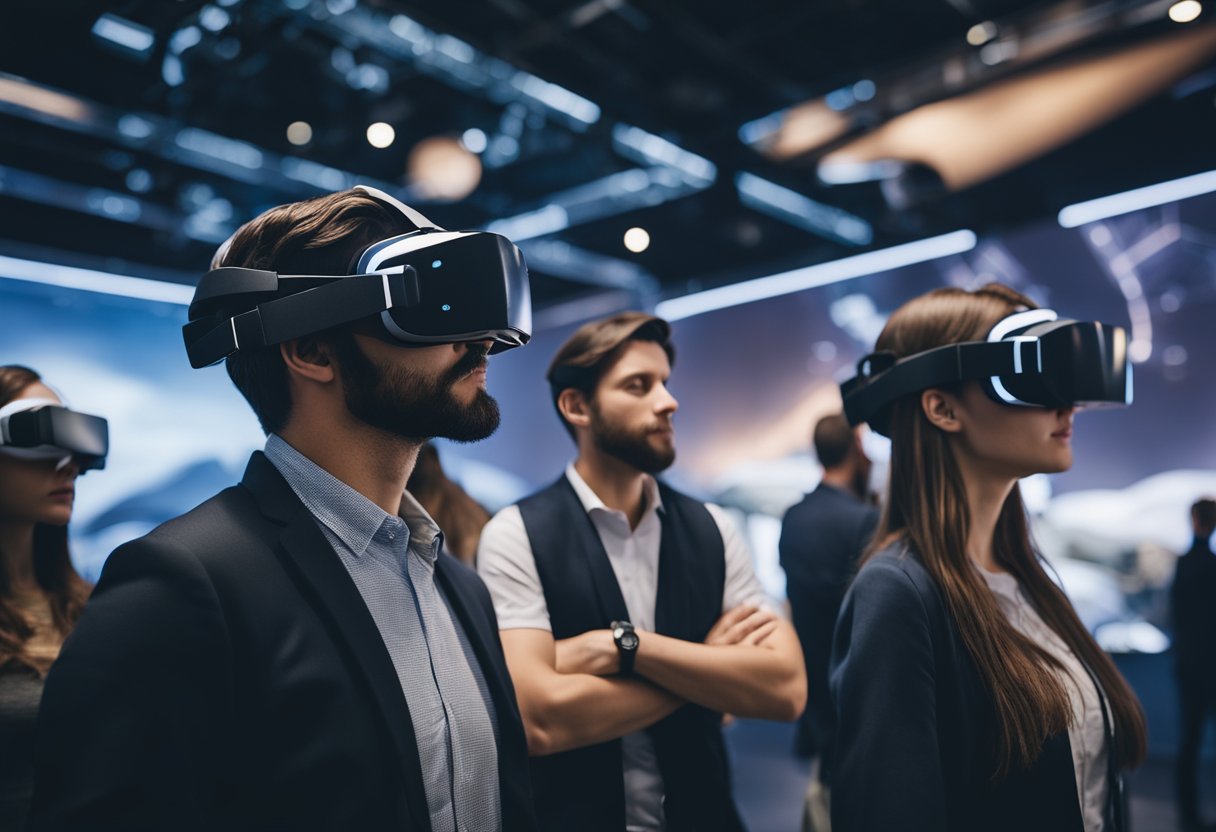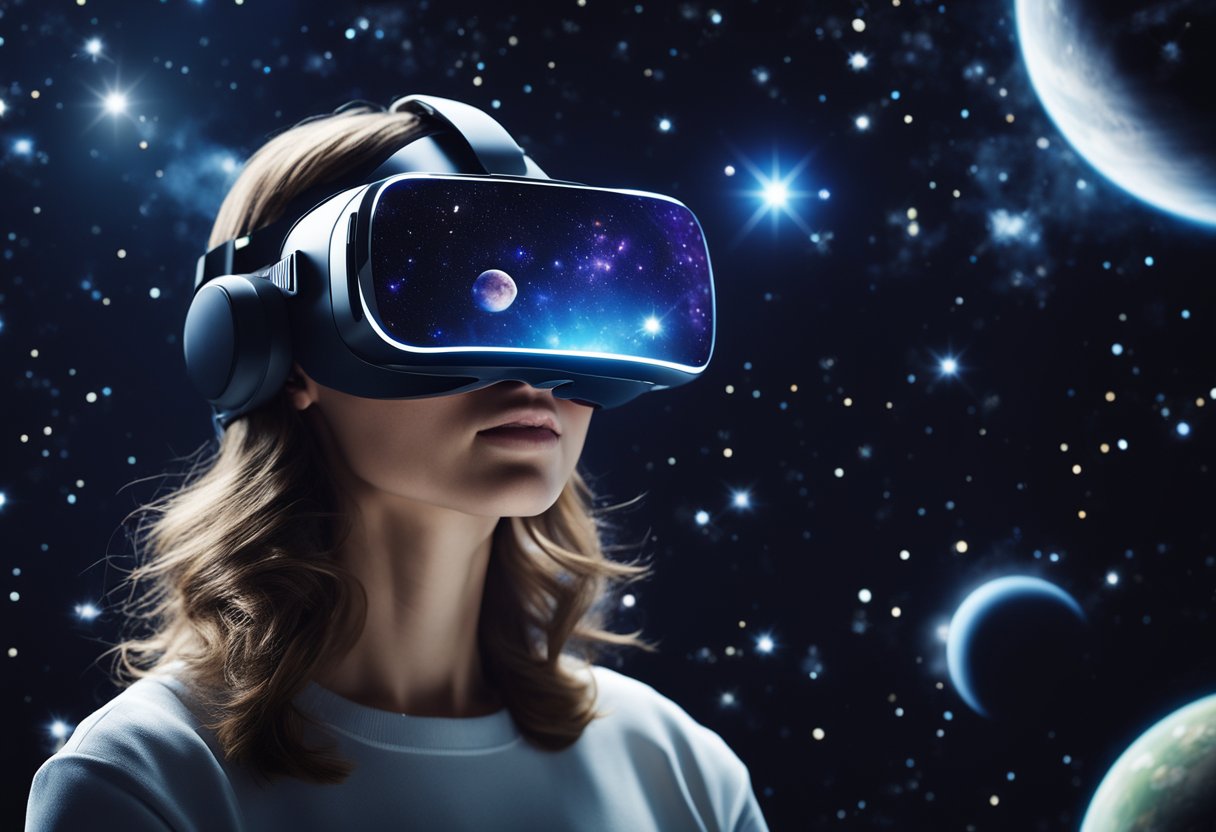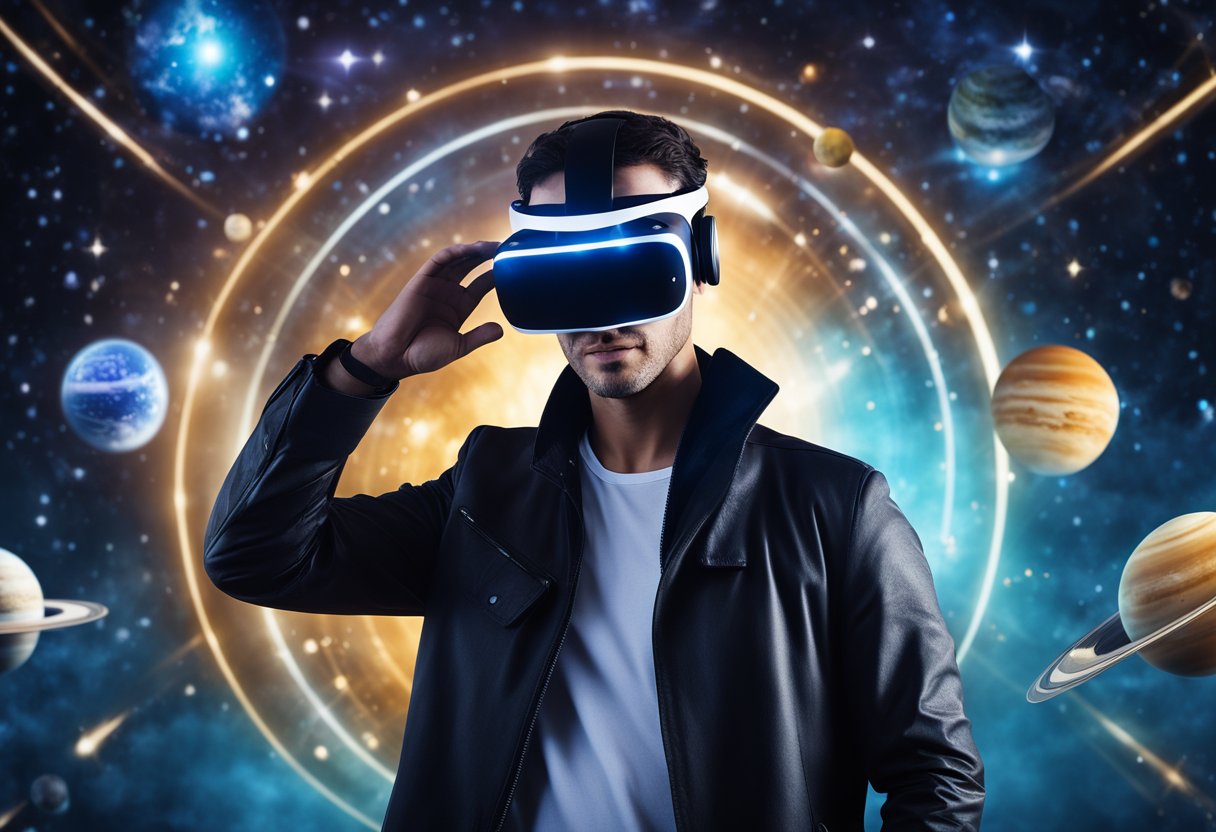
As we delve into the realm of virtual reality (VR), space travel experiences are becoming more immersive and accessible than ever before. The dream of journeying through the cosmos, once the preserve of astronauts and science fiction, is now at our fingertips. Utilising advanced VR technology, these experiences allow us to explore the vastness of space from the comfort of our own homes.

Virtual space travel experiences provide an unparalleled opportunity for learning and entertainment. They bridge the gap between complex astrophysical concepts and public curiosity, enabling us to visit replicated cosmos environments or even the International Space Station. Engaging in these virtual voyages not only feeds our fascination with the universe but also educates us about our place within it.

In the realm of virtual space travel, the heart of the experience is virtual reality (VR) technology. We see VR as the digital simulation of a three-dimensional environment that can be interacted with in a seemingly real or physical way by a person using special electronic equipment, such as a VR headset.
VR headsets have dramatically improved since their inception. The early models were often bulky and offered limited interaction, with low-resolution visuals. Today, devices like the Oculus Rift, HTC Vive, and Valve Index have set industry standards with high-resolution displays and sophisticated tracking systems. These headsets have significantly enhanced the immersiveness of VR, making experiences like space exploration increasingly realistic. Brands such as Meta (formerly Facebook) continue to push the boundaries with each iteration, focusing on improving the user experience.
| Generation | Key Improvements | Popular Models |
|---|---|---|
| 1st | Introduction of head tracking | Early Oculus Rift |
| 2nd | Higher resolutions, better FOV | HTC Vive, Oculus Rift S |
| Current | Wireless options, eye tracking | Valve Index, Oculus Quest 2 |
Many platforms now offer an array of virtual experiences. Oculus platforms, developed by Meta, provide a diverse catalogue of VR content, from gaming to educational programmes. Windows Mixed Reality is another ecosystem which integrates with Microsoft’s computing platforms, offering a seamless experience for users. For those looking to experience virtual space travel, platforms like SpaceVoyageVentures.com give enthusiasts a glimpse into the potential future of space tourism and document trips that are already available, illustrating the intersection of VR capabilities and space exploration ambitions.
We’re living in a remarkable era where virtual travel to the cosmos is accessible from the comfort of our homes. Virtual space travel creates an immersive experience that simulates the awe-inspiring journey through the stars.
Virtual space travel allows us to experience the thrill of cosmic exploration without leaving Earth. By donning a virtual reality (VR) headset, users can embark on virtual adventures that astonishingly replicate what astronauts might see and do. SpaceVoyageVentures.com is a pioneer in this realm, offering insights into not only the virtual journeys available today but also the anticipated ones that the near future holds.
The backbone of virtual space travel lies in advanced technologies like VR and extended reality (XR). These tools craft immersive experiences that convincingly simulate space. Specific hardware, such as VR headsets, and software applications provide the complex visuals and interactions necessary for our virtual adventures. As we explore virtual landscapes, the technology transports us to a universe where travel is unbounded by physical constraints.
We’re entering an era where the vastness of space becomes accessible through virtual reality. From manning a station in orbit to moulding entire galaxies, these experiences promise an immersive glimpse into the cosmos.
This immersive VR experience allows us to explore the International Space Station (ISS) as if we were truly aboard the orbiting laboratory. We can undertake tasks akin to those of real astronauts, experience zero-gravity, and even partake in a spacewalk.
Universe Sandbox is a physics-based space simulator that enables us to create, destroy, and interact on an unimaginable scale. Not only can we simulate the gravity of planets and the collisions of asteroids, but we also have the ability to manipulate the very elements of the cosmos to witness the often beautiful outcomes of cosmic events.
National Geographic Explore VR takes us on meticulously crafted expeditions that replicate the thrill of extreme Earth and space locales. We’re not just passive observers; we engage in interactive tasks like photography or piloting a spacecraft, which enrich our understanding and appreciation of these remote environments.
For those passionate about space exploration, we now have the opportunity to step into the boots of an astronaut from the comfort of our homes. Through virtual reality technology, we can engage in immersive experiences that closely mimic the duties and breathtaking vistas encountered by spacefarers.
Our conception of astronauts has always been that of explorers embarking upon the final frontier. They perform critical tasks in space missions, from conducting scientific research to maintaining the spacecraft. Virtual reality technology allows us to step into these roles, experiencing both the challenges and thrills of space exploration without leaving Earth. Unlike passive observation, these immersive experiences demand our interaction, making us an integral part of the mission.
Spacewalks, or extravehicular activities (EVAs), are some of the most intense and awe-inspiring tasks an astronaut can undertake. Through immersive virtual reality experiences, we’re able to conduct simulated spacewalks where the vastness of the cosmos envelops us. Our participation in a virtual space mission involves navigation in microgravity, manipulating tools to perform repairs, and experiencing the unparalleled view of Earth from above. This unique perspective not only educates us about the intricacies of astronautical duties but deepens our appreciation for space exploration.
With advancements in VR, the day may not be far when we can add our own stories to the adventurers documented on SpaceVoyageVentures.com, a beacon for those looking towards the cosmos with yearning eyes.
We’re about to embark on a virtual journey that spans from the familiar planets orbiting our Sun to the digital construction of distant galaxies. Let’s venture into the vastness of space and glimpse the potential of virtual exploration.
Our solar system, a celestial neighbourhood, is but a speck in the universe. It comprises eight planets, including our own Earth, each orbiting the Sun. These planets provide a sense of the immense scale of the universe as we step into a virtual realm that extends far beyond.
Beyond our solar system, we delve into the wonders of a procedurally generated cosmos. This is a frontier where algorithms create a limitless expanse of stars and galaxies, offering unique and uncharted territories to explore. It is a space where the possibilities for exploration are bound by our imagination rather than physical constraints.

Virtual reality technology is rapidly transforming our visitor experiences at exhibitions and museums. By integrating VR, institutions offer immersive explorations that transcend traditional boundaries, allowing for deep engagement with exhibits and events.
Virtual museums have emerged as a powerful tool to democratise access to cultural heritage and expand our educational horizons. We’re seeing institutions like the Tate Modern leveraging VR to allow visitors to step into paintings or historical scenes, making art and history more interactive and engaging. For those who cannot physically visit, virtual museums offer a compelling substitute, presenting a crowd-free and detailed exploration of exhibitions. Imagine viewing artefacts up-close without any barriers or navigating through rooms of a museum from the comfort of your home – these virtual experiences remove physical limitations and provide access to a larger audience.
Beyond static exhibits, VR also revitalises our enjoyment of concerts and events.
Virtual reality concerts provide a dynamic and crowd-free way for audiences to enjoy performances.
Fans can be part of a live event’s energy without being physically present, breaking down geographical barriers and allowing for a global audience to come together. Event organisers are using VR to craft unique experiences that can include features such as backstage access or a front-row view, which might be impossible in the real world. These digitally-constructed events can mimic the feeling of attending in-person and, in some cases, even enhance it by providing perspectives and interactions a physical event could not.

As we explore virtual space travel experiences, we recognise that the depth and quality of these experiences are greatly enhanced by advanced technologies and digital infrastructure.
The Internet serves as the backbone for immersive virtual experiences, connecting us to a realm of possibilities that extend beyond our physical world. With high-speed internet connectivity, we’re able to access detailed visualisations of space, providing users with an opportunity to explore the cosmos from the comfort of their homes. Websites like SpaceVoyageVentures.com offer portals into these extraordinary journeys, documenting the range of experiences available, from those on the horizon to current and nearly operational space tourism trips.
Virtual events and conferences have transformed from niche occurrences to commonplace events in our digital age. These gatherings utilise digital platforms to host webinars, live streams, and interactive sessions that create a sense of community and shared space, despite participants being miles apart. Attending a conference on the advancements in virtual space travel can now be as simple as logging into a specialised online portal, which can provide immersive experiences and networking opportunities akin to their physical counterparts. By leveraging virtual environments, we transcend geographical barriers, bringing together like-minded individuals and experts in the field of space exploration.

When we venture into virtual space explorations, selecting an optimal VR headset can transform the experience from mundane to extraordinary. Let’s navigate through the essentials.
The market offers a variety of VR headsets, but for an immersive space journey, few match the performance of Oculus Rift or Oculus Quest 2. The Oculus Rift provides a tethered experience, requiring a connection to a powerful PC, whereas the Oculus Quest 2 is a standalone device renowned for its versatility and ease of use.
Ensure compatibility with applications featured on SpaceVoyageVentures.com for a seamless virtual space tourism experience.
We recommend scrutinising product specifications and user reviews to ascertain the headset’s suitability for our virtual space travel needs.
Choosing the correct headset is paramount to ensuring we have the most enriching virtual space excursion, as detailed on platforms like SpaceVoyageVentures.com. Whether we opt for the high-fidelity experience of the Oculus Rift or the convenience of the Oculus Quest 2, we must weigh all factors to make an informed decision that will elevate our interstellar journey.
In our pursuit of cosmic exploration, virtual space travel offers an accessible portal to the stars from the comfort of our own homes. Let us explore how books and resources, along with vibrant online communities, serve as catalysts for our virtual interstellar adventures.
To ignite our imagination, books like ‘The Martian’ by Andy Weir offer a thrilling depiction of survival on Mars, influencing our perspective of space travel. For those of us eager to stay abreast of the latest in space exploration and virtual experiences, the Space.com newsletter serves as an invaluable resource, delivering updates on galactic happenings straight to our inbox.
SpaceVoyageVentures.com stands as an emerging platform dedicated to space tourism, chronicling the potential future, current, and nearly available space tourism trips. It’s a treasure trove where we can find factual information and travel inspiration, fuelling our anticipation for real and virtual space voyages.
Reddit’s r/space and r/virtualreality subreddits provide us with forums where enthusiasts and experts alike convene to share knowledge, experiences, and excitement for virtual space exploration. These communities are instrumental in shaping our understanding and enthusiasm, as we collectively discuss the advancements in technology that bring the cosmos to our living rooms.
By participating in these communities, we deepen our appreciation for virtual space travel, gaining insights into the most immersive experiences and discussing the impact of space exploration on our society.
In the realm of virtual space travel experiences, we are witnessing a substantial impact on education and understanding of our own planet. Our interest goes beyond mere exploration; it’s an educational journey that enhances our knowledge of Earth and the challenges it faces.
When we undertake virtual journeys through space, we arm ourselves with a profound appreciation for the fragility and uniqueness of our home planet. Viewing Earth from a cosmic vantage point, educational content can be designed to highlight the intricate patterns of weather, the vastness of the oceans, and the complexity of ecosystems that are not as perceptible from the ground. Such experiences foster a deeper connection with our world and inspire a sense of stewardship.
Our virtual voyages also offer a stark visualisation of global warming effects on Earth. By simulating the changing climate patterns and the resulting impact on diverse landscapes, we can provide immersive education that underscores the urgency of environmental issues. This virtual lens allows us to understand the consequences of human actions, galvanising a collective effort to combat climate change for the survival of our planet.
Through SpaceVoyageVentures.com, we inform and inspire prospective space tourists about these virtual expeditions. Our aim is to make space tourism not just an aspiration but a conduit for real-world education on the pressing issues Earth faces. Our commitment extends to ensuring that each virtual trip is a gateway to understanding and protecting our home planet for future generations.
As we explore the concept of virtual tourism, it’s essential to understand how it intersects with the burgeoning field of virtual reality (VR) and its potential to redefine travel experiences.
Through virtual tours, we’re witnessing a revolution in how people experience the world’s wonders. Google Earth stands as a pioneering force, offering users the chance to visit Earth’s nooks and crannies with a few clicks. The immersive aspect of these tours on VR platforms has elevated the educational value, providing a rich, engaging way to learn about different cultures and environments from the comfort of one’s home.
The VR travel market is rapidly expanding, with platforms dedicated to bringing distant destinations into our living rooms. SpaceVoyageVentures.com is an example of how the market is extending to extraterrestrial realms, promising future opportunities for virtual space exploration. The growth of VR platform technology is pivotal, ensuring that virtual travel experiences continue to become more authentic and interactive.

In our quest to make space more accessible, we have compiled a list of the most common inquiries about virtual reality space experiences. Our aim is to give you a better understanding of the opportunities available within the realm of virtual space exploration.
One of the highest-praised experiences is Space Explorers: The ISS Experience, allowing users to immerse themselves aboard the International Space Station. Additionally, SpaceVoyageVentures.com provides insights into various existing and upcoming virtual space travel opportunities.
Yes, there are free virtual space experiences available online. For instance, Google Earth’s Voyager feature provides interactive space exploration stories without any cost.
Virtual reality space tours typically use a combination of head-mounted displays, spatial audio, and motion tracking to create a lifelike environment. They replicate the zero-gravity of space and the visuals of the cosmos to give users a realistic sensation of being in space.
Certainly, there are virtual field trips like the one offered by Studies Weekly, which features an educational tour of NASA’s Kennedy Space Center, geared specifically towards younger learners.
NASA utilises VR to enhance learning through interactive simulations of space missions and celestial bodies. These experiences are crafted to educate and inspire students about space science and technology.
Local options will vary, but many science museums and planetariums now feature VR installations. Additionally, home VR headsets like Oculus Quest provide access to space-oriented VR experiences, enabling immersive space journeys from the convenience of your home.